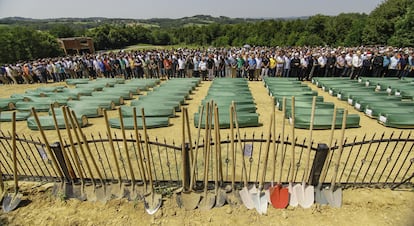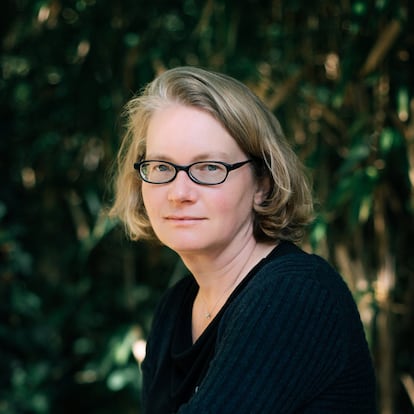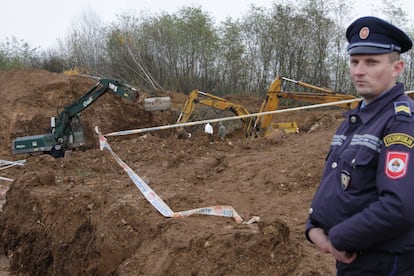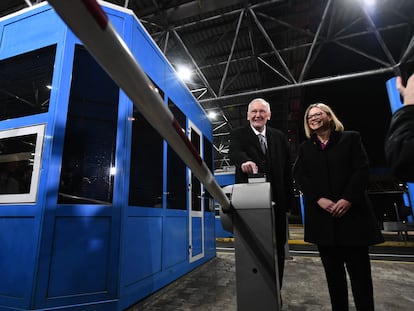The unhealed wounds of the Bosnian War: ‘Nothing prepared me to look at a mass grave’
In a book, the journalist Taina Tervonen recounts the endless search for those who disappeared during the conflict, through a forensic anthropologist and a researcher


A truck can tell the story of a genocide. In the 2018 film The Load, directed by Ognjen Glavonic, a driver transports mysterious merchandise between Kosovo and Belgrade during the NATO bombings of 1999. The viewer eventually discovers that the cargo consists of the bodies of Albanians — the victims of ethnic cleansing at the hands of Serb paramilitaries. They were moved from one place to another, so as to not leave traces of mass murder.
In her book Les fossoyeuses (available in French and Spanish, and whose title can be translated as The Gravediggers) — a book about the mass graves of Bosnia-Herzegovina — journalist Taina Tervonen writes: “Maybe, the first thing that should be done when investigating genocide is to question truck drivers, bus drivers and train conductors. They know. Just like the [driver] who led investigators to the Tomasica grave.”
This 49-year-old Franco-Finnish writer reconstructs the Bosnian War (1992-1995) through the most painful mark it has left: the mass graves, filled with thousands of people who still remain missing. She does this through two characters: Senem — a forensic anthropologist — and Darija, a researcher, who have been helping families in this painful search since the end of the genocide, when they were in their twenties. The pages also feature dozens of people who saw their world engulfed by violence overnight, who watched as their neighbors denounced, murdered and tortured people they had known forever.
One of the first discoveries that Tervonen made when she began accompanying forensic anthropologists is that the sickly-sweet smell of death never really goes away. It stays on the nose, on the clothes… but above all, in the mind. Her other crucial finding was that mass murder requires enormous planning and infrastructure, as well as the complicity of many people. The executioners almost never kill alone.

When Tervonen contemplated the enormous mass grave of Tomasica — discovered in 2013, precisely thanks to the testimony of one of the drivers who transferred the corpses — she saw, before her very eyes, evidence of the genocide that Serb nationalists committed against Bosnian Muslims. She could see that it had been meticulously planned.
Nearly 500 corpses appeared in that old mine, of which only half have been identified. The rest represent families who have never been able to grieve and who still face painful, unanswered questions.
“I wondered many times about the logistics of a genocide,” she explains in a telephone call from Paris, where she lives. “Hundreds of people cannot be executed without [the operation] having been previously planned and organized. It’s necessary to get weapons, ammunition, decide what’s going to be done with the bodies, where the killings are going to take place. Many of the stories that I have heard refer to the issue of transportation: it’s always at the center of mass deportations.”
“I also thought about the drivers. They are very important characters,” the writer adds. “These are survivors, who may have played a crucial role in the killings… but who can also save people’s lives.”
She recounts the story of a bus driver who had to transport Bosnian Muslims who had been driven from their homes. He refused to let soldiers into the vehicle… a gesture that prevented another massacre.

“When I got here, I didn’t know what to expect,” the author confesses at the start of the book. “Nothing had prepared me to look at a mass grave. A mass grave is work. There is no room for ideas in front of that huge hole from which the bodies must be extracted before winter comes.”
Contact with forensic fieldwork marks all of Tervonen’s reporting, which is tinged with admiration for people who dedicate their lives to looking for corpses. They not only face the smell of death, but also the pain of families. They are the ones who dig, but they also research and compare DNA samples to try to close thousands of missing persons cases that were left open after a war during which 100,000 people were killed, most of them civilians.
“Senem and Darija are two very strong women. They haven’t chosen what they are dedicated to: they found themselves doing this work a bit by chance,” the author points out. “And it’s heavy and very meticulous work. It also requires enormous empathy towards families, but also a certain distance. It’s a job that deals with humanity: a disappeared person must become a deceased person.”
This work involves professionals who have traveled to places where massacres have taken place all around the world — Argentina, Peru, Guatemala, Iraq, the Balkans and now Ukraine — and who never get used to death or the endless pain of survivors. This kind of work has been chronicled in other books, such as Like Eating a Stone: Surviving the Past in Bosnia, by W.L. Tochman, or in the reports filed by Spanish reporter Gervasio Sánchez on disappeared people in different conflicts.
José Pablo Baraybar, a Peruvian forensic anthropologist, once located a mass grave in Kosovo: “There are common threads in all the cases of the disappeared that I have dealt with in my life. One of them is that there are always women walking; women, because the victims of this type of crime are usually men. [The women] walk because they go from one place to another, looking for their disappeared.”
The cases of missing persons in Europe no longer stem solely from wars and ethnic cleansing. Tervonen has also worked in the immense mass grave that the Mediterranean has become, where thousands of people have drowned — and continue to drown — while trying to seek refuge in Europe, as they flee from war, famine and misery.
“I have found that same smell of death on a ship that was carrying dozens of the dead from a shipwreck in Sicily,” she recalls.

The Bosnian case is especially complicated because, when the end of the war was nearing — especially after mass graves were identified by satellite after the Srebrenica massacre, considered a genocide by the International Criminal Court — the perpetrators moved corpses from one grave to another in such a way that the remains of the same victim can be scattered in many places.
The International Commission on Missing Persons was created in 1997 to try to identify the disappeared through DNA, which has to be collected from relatives. It’s what Darija is dedicated to. Her mission is not only to search for genetic remains, but to reconstruct the stories — the lives of human beings — that the corpses hide.
All the information is entered into a database and crossed-checked by using a proprietary program until it gives positive results. Subsequently, when there is greater than 99.95% certainty that the corpse is, in fact, the missing person, a traditional identification process begins, requiring information from after and before their murder. This technique — first used in Bosnia — was later applied in the aftermath of the 9/11 attacks, the 2004 Tsunami and the invasion of Iraq.
While there are still thousands of cases to close, Darija now works alone and covers a third of Bosnia-Herzegovina. Almost 30 years have passed since the end of the genocide… but the machine of death and horror hasn’t stopped. Today, forensic teams are working in Syria, Iraq and Ukraine. The Bosnian war seems far away, unfairly forgotten, Tervonen argues.
“It has been said many times that [Ukraine] is the first war in Europe in decades. This is false. I don’t really know why what happened in Bosnia has been forgotten. Maybe because it was too close to us –— that’s why we don’t feel like remembering it.”
Sign up for our weekly newsletter to get more English-language news coverage from EL PAÍS USA Edition
Tu suscripción se está usando en otro dispositivo
¿Quieres añadir otro usuario a tu suscripción?
Si continúas leyendo en este dispositivo, no se podrá leer en el otro.
FlechaTu suscripción se está usando en otro dispositivo y solo puedes acceder a EL PAÍS desde un dispositivo a la vez.
Si quieres compartir tu cuenta, cambia tu suscripción a la modalidad Premium, así podrás añadir otro usuario. Cada uno accederá con su propia cuenta de email, lo que os permitirá personalizar vuestra experiencia en EL PAÍS.
¿Tienes una suscripción de empresa? Accede aquí para contratar más cuentas.
En el caso de no saber quién está usando tu cuenta, te recomendamos cambiar tu contraseña aquí.
Si decides continuar compartiendo tu cuenta, este mensaje se mostrará en tu dispositivo y en el de la otra persona que está usando tu cuenta de forma indefinida, afectando a tu experiencia de lectura. Puedes consultar aquí los términos y condiciones de la suscripción digital.
More information
Archived In
Últimas noticias
Most viewed
- Sinaloa Cartel war is taking its toll on Los Chapitos
- Oona Chaplin: ‘I told James Cameron that I was living in a treehouse and starting a permaculture project with a friend’
- Reinhard Genzel, Nobel laureate in physics: ‘One-minute videos will never give you the truth’
- Why the price of coffee has skyrocketed: from Brazilian plantations to specialty coffee houses
- Silver prices are going crazy: This is what’s fueling the rally










































